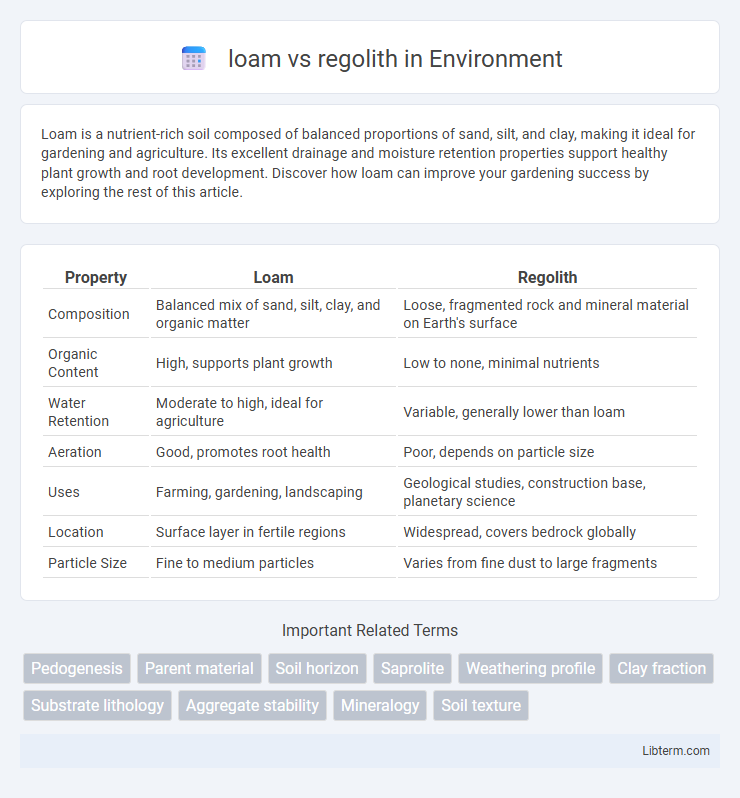Loam is a nutrient-rich soil composed of balanced proportions of sand, silt, and clay, making it ideal for gardening and agriculture. Its excellent drainage and moisture retention properties support healthy plant growth and root development. Discover how loam can improve your gardening success by exploring the rest of this article.
Table of Comparison
| Property | Loam | Regolith |
|---|---|---|
| Composition | Balanced mix of sand, silt, clay, and organic matter | Loose, fragmented rock and mineral material on Earth's surface |
| Organic Content | High, supports plant growth | Low to none, minimal nutrients |
| Water Retention | Moderate to high, ideal for agriculture | Variable, generally lower than loam |
| Aeration | Good, promotes root health | Poor, depends on particle size |
| Uses | Farming, gardening, landscaping | Geological studies, construction base, planetary science |
| Location | Surface layer in fertile regions | Widespread, covers bedrock globally |
| Particle Size | Fine to medium particles | Varies from fine dust to large fragments |
Understanding Loam: Definition and Properties
Loam is a fertile soil composed of approximately 40% sand, 40% silt, and 20% clay, offering an ideal balance of drainage and nutrient retention for plant growth. Its granular texture allows for optimal aeration and moisture retention, making it highly conducive to agriculture and gardening. Unlike regolith, which includes loose, heterogeneous materials covering solid rock and can range from dust to gravel, loam specifically refers to a nutrient-rich soil type critical for sustaining healthy ecosystems.
What is Regolith? Key Characteristics
Regolith is a loose layer of fragmented rock and dust covering solid bedrock on planetary surfaces, including Earth, the Moon, and Mars. It consists of diverse materials like soil, dust, broken rock, and other related minerals, often lacking organic content. Key characteristics include its unconsolidated texture, variable thickness, and its role in influencing surface processes such as erosion, habitat for plant roots, and water infiltration.
Formation Processes: Loam vs Regolith
Loam forms through the weathering of minerals combined with organic matter accumulation, resulting in a balanced mixture of sand, silt, and clay particles ideal for plant growth. Regolith develops from the physical and chemical breakdown of underlying bedrock, encompassing all loose, heterogeneous material covering solid rock, including dust, soil, broken rock, and other related materials. The key distinction lies in loam being a specific soil type enriched with organic content, whereas regolith represents a broader geological layer of unconsolidated material.
Texture and Composition Comparison
Loam consists of a balanced mixture of sand, silt, and clay particles, providing a fertile, well-draining texture ideal for plant growth. Regolith is a broader geological material comprising fragmented rock, dust, and mineral particles of varying sizes, often lacking the organic content present in loam. The composition of loam supports nutrient retention and moisture, while regolith's texture ranges from fine dust to coarse debris, influencing its permeability and suitability for different ecological functions.
Nutrient Availability in Loam and Regolith
Loam contains a balanced mix of sand, silt, and clay, providing high nutrient availability essential for plant growth due to its excellent water retention and organic matter content. Regolith, composed mainly of weathered rock and mineral fragments, typically has lower nutrient levels and poorer water retention, limiting its capacity to support robust plant development without amendments. The nutrient richness in loam makes it ideal for agriculture, while regolith often requires significant enrichment to enhance fertility.
Water Retention and Drainage Differences
Loam soil, composed of a balanced mix of sand, silt, and clay, exhibits excellent water retention and efficient drainage, promoting optimal moisture availability for plant roots. Regolith, consisting mainly of weathered rock fragments and minerals with minimal organic matter, tends to have poor water retention and inconsistent drainage due to its coarse texture and low porosity. Understanding these differences in hydraulic properties is crucial for agriculture, landscaping, and groundwater recharge applications.
Agricultural Uses: Loam vs Regolith
Loam is highly valued in agriculture for its balanced texture and nutrient-rich composition, providing optimal water retention and aeration essential for crop growth. Regolith, being a more heterogeneous and mineral-rich layer, often lacks organic matter and requires amendment before supporting sustainable plant cultivation. Farmers prefer loam for its fertility and ease of cultivation, while regolith is typically studied for potential use in extraterrestrial agriculture due to its raw, unweathered properties.
Loam and Regolith in Environmental Science
Loam is a fertile soil composed of roughly 40% sand, 40% silt, and 20% clay, providing optimal water retention and aeration for plant growth in environmental science. Regolith refers to the loose, heterogeneous layer of dust, soil, and broken rock covering solid bedrock on Earth or other planetary bodies, serving as a crucial substrate for geological and ecological processes. Understanding the differences between loam and regolith helps in soil management, erosion control, and habitat restoration efforts.
Challenges of Working with Loam and Regolith
Working with loam poses challenges such as its variable moisture retention and compaction tendencies, which can affect plant growth and soil aeration. Regolith, often found on extraterrestrial surfaces, presents difficulties due to its abrasive texture, lack of organic material, and potential for toxic elements, complicating its use for agriculture and construction. Both materials require specialized techniques to optimize their properties for sustainable use in agriculture or habitat development.
Choosing the Right Soil: Loam or Regolith?
Loam is a nutrient-rich, well-draining soil composed of balanced sand, silt, and clay, making it ideal for agriculture and gardening due to its moisture retention and aeration properties. Regolith refers to the loose, heterogeneous layer of dust, soil, and broken rock covering solid rock on Earth and other planetary bodies, often lacking organic material and nutrients necessary for plant growth. Choosing between loam and regolith depends on the intended use; loam supports robust plant development, while regolith requires significant amendment or treatment for effective cultivation.
loam Infographic

 libterm.com
libterm.com